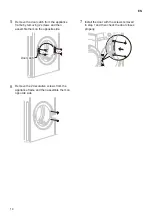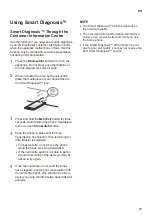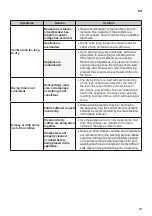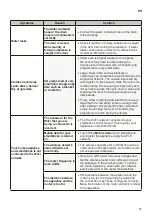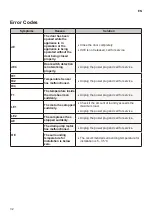
28
EN
TROUBLESHOOTING
The appliance is equipped with an automatic error-monitoring system to detect and diagnose problems at
an early stage. If the appliance does not function properly or does not function at all, check the following
before you call for service:
Diagnosing Problems
Symptoms
Reason
Solution
Appliance will not turn
on.
Power cord is not
properly plugged in.
•
Make sure that the plug is securely plugged
into a grounded outlet matching the appliance’s
rating plate.
House fuse is blown,
circuit breaker has
tripped, or power
outage has occurred.
•
Reset circuit breaker or replace fuse. Do not
increase fuse capacity. If the problem is a
circuit overload, have it corrected by a qualified
electrician.
Appliance does not
heat.
House fuse is blown,
circuit breaker has
tripped, or power
outage has occurred.
•
Reset circuit breaker or replace fuse. Do not
increase fuse capacity. If the problem is a
circuit overload, have it corrected by a qualified
electrician.
Clothes take too long
to dry.
Load is not properly
sorted.
•
Separate heavy items from lightweight items.
Larger and heavier items take longer to dry.
Light items in a load with heavy items can fool
the sensor because the light items dry faster.
Large load of heavy
fabrics.
•
Heavy fabrics take longer to dry because they
tend to retain more moisture. To help reduce and
maintain more consistent drying times for large
and heavy fabrics, separate these items into
smaller loads of a consistent size.
Appliance controls are
not set properly.
•
Use the appropriate control settings for the type
of load you are drying. Some loads may require
an adjustment of the dry level setting for proper
drying.
Lint filter needs to be
cleaned.
•
Remove the lint from the lint filter before every
cycle. With the lint removed, hold the lint filter
up to a light to see if it is dirty or clogged. With
some loads that produce high amounts of lint,
such as new bath towels, it may be necessary
to pause the cycle and clean the filter during the
cycle.

